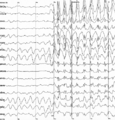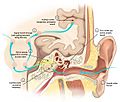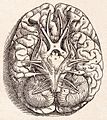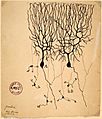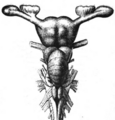Vertebrate brain facts for kids
The vertebrate brain is the main part of the central nervous system. In vertebrates (and most other animals) the brain is at the front, in the head. It is protected by the skull and close to the main senses of vision, hearing, balance, taste, and smell. As an animal moves forward, its senses collect data about the surroundings, and that data goes directly to the brain.
Brains are extremely complex. The brain controls the other organs of the body, either by activating muscles or by causing secretion of chemicals such as hormones and neurotransmitters. Muscular action allows rapid and coordinated responses to changes in the environment; hormones and the autonomic nervous system make slower changes in the body. It is also a part of human and animal body. The brain of an adult human weights about 1300–1400 grams
In vertebrates, the spinal cord by itself can cause reflex responses as well as simple movement such as swimming or walking. However, sophisticated control of behaviour requires a centralized brain.
The structure of all vertebrate brains is basically the same. At the same time, during the course of evolution, the vertebrate brain has undergone changes, and become more effective. In so-called 'lower' animals, most or all of the brain structure is inherited, and therefore their behaviour is mostly instinctive. In mammals, and especially in man, the brain is developed further during life by learning. This has the benefit of helping them fit better into their environment. The capacity to learn is seen best in the cerebral cortex.
Three principles
- The brain and nervous system is essentially a system which makes connections. It has input from sense organs and output to muscles.
It is connected in several ways with the endocrine system, which makes hormones, and the digestive system and sex system. Hormones work slowly, so those changes are gradual. - The brain is a kind of department store. It has, all inter-connected, departments which do different things. They all help each other gather senses.
- Much of what the body does is not conscious. A person breathes, heart beats, intestines digest, hair grows, thoughts pop into their mind... Some of this can be noticed by a person, and some (like breathing) can be influenced to some extent. But, basically, much of the body runs on automatic, adjusted by the autonomic nervous system.
The brain, too, does much of its work without a person noticing it. The unconscious mind refers to the brain activities which are seldom noticed.
Vertebrate brain regions
Several brain areas have kept their identities across the whole range of vertebrates, from hagfishes to humans. Here is a list of some of the most important areas, with a brief description of their functions as currently understood. These functions may still be disputed to some degree. Starting from the back (or, in humans, the underneath part) the regions are:
- The medulla (and the spinal cord) have many small nuclei, which deal with various autonomic functions. These include the heart beat and blood pressure, breathing, and vomiting.ch 44, 45
- The pons is a relay station, carrying messages between the cerebrum and the medulla and cerebellum.
- The hypothalamus is a small region at the base of the forebrain. It is the central control station for sleep/wake cycles, control of eating and drinking, control of hormone release, and many other functions. It sits immediately above the pituitary gland, and secretes hormones into the gland. These hormones inhibit or stimulate the pituitary gland. The gland, in turn, makes hormones which affect the rest of the body.
- The thalamus sits above the hypothalamus, and below the cerebral cortex. It is a collection of nuclei with various functions. It acts as a relay station, gathering sense information of all kinds (except olfactory) and passes it on to the cerebral cortex. Also, it has a role in consciousness and sleep.
There are action systems for several types of behaviour, including eating, drinking, defecation, and copulation. - The cerebellum adjusts the output of other brain systems to make them more precise. Removal of the cerebellum does not prevent an animal from doing anything in particular, but it makes actions hesitant and clumsy. This precision is not built-in, but learned by trial and error. Learning how to ride a bicycle is an example of a type of neural plasticity that may take place largely within the cerebellum.ch 42
- The tectum, often called 'optic tectum', directs actions to points in space. Its best studied function is to direct eye movements. It also directs reaching movements. It gets strong visual inputs, and inputs from other senses which are useful in directing actions, such as auditory input in owls, input from the thermosensitive pit organs in snakes, etc. In some fish, such as lampreys, it is the largest part of the brain.
- The hippocampus is, strictly speaking, only in mammals, but it has counterparts in all vertebrates. It is involved in spatial memory and navigation in fishes, birds, reptiles, and mammals.
- The basal ganglia are a group of structures in the forebrain, which are strongly connected to the cerebral cortex and the thalamus. The main function of the basal ganglia seems to be selecting actions. They send inhibitory signals to all parts of the brain that can generate actions. In the right circumstances they release the inhibition, so that the action-generating systems can execute their actions. Rewards and punishments exert most important neural effects on the basal ganglia.
- The cerebral cortex is a layer of grey cells that is on the surface of the forebrain. It is involved in multiple functions, including olfaction and spatial memory. In mammals, where it dominates the brain, it controls functions from many subcortical areas.
- The olfactory bulb is a special structure that processes olfactory sensory signals (smells), and sends its output to the olfactory part of the cerebral cortex. It is a major brain component in many vertebrates, but much reduced in primates.
Brain size
The relationship between brain size, body size and other variables has been studied in a wide range of vertebrate species. Brain size increases with body size but not proportionally.
Mammals
Averaging across all mammals, it follows a power law, with an exponent of about 0.75. This formula applies to the average brain of mammals but each family departs from it, reflecting their sophistication of behavior. For example, primates have brains 5 to 10 times as large as the formula predicts. Predators tend to have larger brains. When the mammalian brain increases in size, not all parts increase at the same rate. The larger the brain of a species, the greater the fraction taken up by the neocortex.
Images for kids
-
Neurons generate electrical signals that travel along their axons. When a pulse of electricity reaches a junction called a synapse, it causes a neurotransmitter chemical to be released, which binds to receptors on other cells and thereby alters their electrical activity.
-
Brain electrical activity recorded from a human patient during an epileptic seizure.
-
Diagram of signal processing in the auditory system.
-
Cross-section of a human head, showing location of the hypothalamus.
-
Illustration by René Descartes of how the brain implements a reflex response.
-
Andreas Vesalius' Fabrica, published in 1543, showing the base of the human brain, including optic chiasma, cerebellum, olfactory bulbs, etc.
-
Drawing by Santiago Ramón y Cajal of two types of Golgi-stained neurons from the cerebellum of a pigeon.
-
Gulai otak, beef brain curry from Indonesia
-
The brain of a shark.





